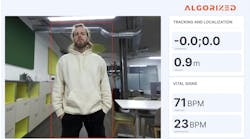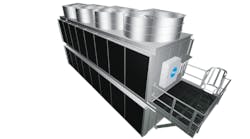About 10 years ago, engineers at Cleveland’s TECT Corp. forging plant looked closely at how they inspected products and associated tooling — and they were not happy with what they found.
Times had changed, as did their customers’ delivery requirements, which had become more sophisticated. While the number of blade designs and sizes had increased dramatically, the size of production runs had diminished and customers were demanding shorter lead times. They also wanted more and better quality verification, but the shorter production runs were making it harder to maintain profitability when a $50,000-60,000 guillotine gauge was required to inspect every new blade design.
There were other problems with guillotine gauges. Long lead times in manufacturing made gauging acquisition a bottleneck in the manufacturing process development cycle. Even worse, if blade designs changed along the way, the gauges had to be sent out for rework, adding cost and delays. Finally, these hard gauges provided only go/no-go information rather than variable data that could be used to track manufacturing process changes over time and institute corrective measures as needed to avoid scrap generation.
Axing Guillotines First
To reduce dependency on the ubiquitous hard gauges TECT partnered with its CMM software provider, Wilcox Associates/PC-DMIS (www.pcdmis-ems.com) to develop a powerful airfoil package that would support its diverse analysis and reporting requirements. They chose PC-DMIS because it was the only software that allowed for an iterative alignment of unfixtured parts by taking six measurements with the CMM and establishing the best fit between the data and the CAD model. Otherwise, expensive fixtures would have been required to locate parts on the CMM, wiping out any savings derived from eliminating hard gauges. The software features advanced scanning capabilities for capturing large amounts of analysis data from blade surfaces. Within three years, the company was no longer purchasing guillotine gauges to support new projects. Ray Prosek, TECT Corp.’s process control manager, said these avoided cost savings have totaled almost $600,000 to date — enough to offset the company’s on-going investment in CMMs, software, probing technology, and network infrastructure. These acquisitions have allowed TECT Corp. to build on the core technologies of PC-DMIS to create an integrated EMS (Enterprise Metrology System) spanning design, engineering, and manufacturing.
An Evolving EMS
TECT Corp.’s EMS improves inspection performance while reducing inspection costs. It provides readily accessible quantitative information for making informed decisions about improving lean manufacturing processes.
Today, TECT Corp.’s EMS consists of four networked Brown & Sharpe CMMs (one in the engineering lab, three in an environmentally controlled room adjacent to the manufacturing floor); multiple Data Collection Probes (including an SP 600 continuous scanning probe and a Metris Laser scanning probe capable of capturing clouds of data points at a single pass); PC-DMIS CAD++ dimensional measurement software used to control each of the CMMs; a workstation hosting PC-DMIS off-line, which allows for the development, testing, and debugging of inspection programs without tying up expensive measurement machines; a robust database for collecting and archiving all PC-DMIS programs, dimensional data, analyses, and reports; DataPage RT real-time SPC reporting software; PC-DMIS Blade analysis and reporting software; bar-coding software and label printer; and a proprietary software package to create airfoil surfaces from point clouds captured by the laser probe.
How It Works
The EMS has become an integral part of the manufacturing process. Hourly workers use the measurement systems to check parts for the verification and adjustment of tooling set-ups for critical final forging operations. The appropriate PC-DMIS measurement program for the part is selected from an archive of nearly 100 programs by clicking on part numbers from a simple pull-down menu. The software then displays a picture of the part and its appropriate orientation on a near-position holding fixture.
When the worker has positioned the part he or she initializes the software, driving the CMM through a sequence of point measurements, using these to create an alignment. If the alignment converges within programmer-defined limits, PC-DMIS creates a matrix that exactly locates the part within the machine space, and the system automatically executes a complete inspection. If not, it reiterates the alignment sequence until it achieves convergence and continues.
Measurement data travels over the network to the engineering lab’s EMS database where PC-DMIS Blade analyzes it. This software generates a report showing individual cross sections of the airfoil annotated with critical data. The package also generates textual reports providing dimensional or statistical data in a tabular format, which might include leading edge, trailing edge, and maximum thickness for 20 sections, all on a single page.
At the end of each production run, operators measure the last forging with PC-DMIS and analyze the results carefully to determine if the tooling needs any rework. With this approach, tools retrieved from storage for subsequent runs are always production ready.
In the engineering lab a CMM equipped with a continuous scanning and, more recently, a laser-scanning probe measures existing tools. Engineers use the resulting information to identify any modifications that shop-floor personnel made to make the tools run better. They incorporate these changes into the CAD model and CNC programs to ensure that they reflect the optimized tools actually used in production.
TECT Corp. also is embarking on a program to digitize smaller tools that it currently manufactures using EDM. This information will be fed into the CAD system to generate CNC programs for making these tools on the company’s new high-speed milling equipment.
No matter where or how they are generated, all of the part and tooling inspections and reports, as well as inspection programs, are retained in the EMS database. Authorized personnel can readily obtain this information from any device on the network.
Multiple Advantages
The operational improvements and associated cost reductions realized by using common data-collection programs and analytical tools and networking them throughout the enterprise have been substantial.
More precise manufacturing. Graphic reports generated by the airfoil analysis package detail where critical areas of the blade deviate from the CAD nominal, and by how much they deviate. This allows technicians to make subtle modifications to the tooling for more precise forgings.
TECT makes two types of blade forgings: precision forgings, which only require polishing before shipping; and near-net-shape forgings, which require subsequent machining. In the first instance, more precise forging results in a more precise end product. In the latter, greater precision means far less metal must be removed during subsequent machining of the blade. This is a great cost saver.
TECT has put physical markers on some of its parts (with bar codes and other means) to track dimensional variation. “We want to maintain traceability as far back into our process as we can,” Prosek said.
Higher yields. Blade analysis has given TECT a quantifiable methodology for determining if areas of surface imperfections are within allowable tolerances. This is done by selecting the area in question on the CAD model of the forging, scanning it with the CMM and comparing the data to the same area on the CAD model of the machined, finished part. If there is enough material in the part, TECT will mark the blemished area in yellow to indicate that it has passed a quality/engineering review.
Prosek said the entire process of setting the part on the CMM, locating it in the space using the itrerative alignment process, scanning, and analyzing, takes about 10 minutes. According to Prosek, a much higher percentage of parts now pass review using this procedure.
Faster set-ups. Variable information blade-analysis reports give precise information for modifying or adjusting tooling to achieve an accurate, stable manufacturing process. In the past this type of variable information was obtained only by using feeler gauges to measure gaps between the guillotine gauge and the part, a very time-consuming process.
Improved tooling life. The forging process, with temperatures in excess of 1,600°F and forging pressures in the range of 12,000 tons, is very abusive to the tooling. Prior to being forged, titanium billets and preforms are coated with an aqueous suspension of glass particles to prevent oxidation. While this coating provides some lubrication, it also can accelerate die wear in areas where the suspension accumulates.
Recently, Prosek has been studying blade measurement data archived in the EMS database to determine how tooling wear progresses in various areas of the part over a single production run. With this information, it is possible to alter some of the tooling dimensions to compensate for progressive wear, making it less likely that the tooling will require machining before the completion of the run.
Versatile measurement. When large- and even medium-sized parts are removed from the forging process, they frequently bend and distort under their own weight. In this condition, many do not fit in hard gauges for inspection and cannot go on to subsequent processes until they are reheated and warm-straightened on a special press. The CMMs can measure parts regardless of their distorted condition. This provides immediate variable data, quantifying how badly and in what manner parts are distorted, so that process corrections can be made.
Precision tool-making. Recently TECT Corp. purchased a high-speed ultra-precision milling machine it uses for making its forged parts tooling. The result: more precise, better wearing tools that introduce more precision into the forging process, which, in turn, reduces manufacturing costs by further minimizing downstream operations.
Prosek has been using the CMM and analog-scanning probe to digitize tools that TECT currently makes using EDM equipment. The use of a laser probe capable of capturing thousands of points at a time is streamlining this process. It is fasterand provides much more data. This vastly improves the reverse-engineering project to duplicate legacy tooling for full integration into the forging process.
Eventually, Prosek intends to use the laser probe technology to inspect blades and tooling. With the laser probe, he believes that it will be possible to obtain a complete characterization of the blade’s geometry in less than an hour — a fraction of the time it currently takes to measure critical sections of a blade with hard probes.
Reduced lead times. When the availability of materials, particularly titanium, is not a problem, high-speed milling and dimensional data feedback from the EMS have allowed the company to honor most requests. This reduces the turnaround time from receipt of a CAD drawing to production of the first parts.
Under typical circumstances, Prosek says his company has demonstrated that it can shave weeks off standard lead times quoted throughout the forging industry.
Reducing the need for additional hard gauges has allowed TECT Corp. to avoid costs. These savings can offset the costs of acquiring the CMMs, software, probing technology, and network infrastructure as part of TECT’s EMS.
However, Prosek believes the real winners are the customers who benefit from faster turnaround, longer-lasting tooling, improved manufacturing precision, more customizable quality documentation, and an agile EMS that can be adopted to monitor and troubleshoot evolving quality, delivery, and cost requirements.









